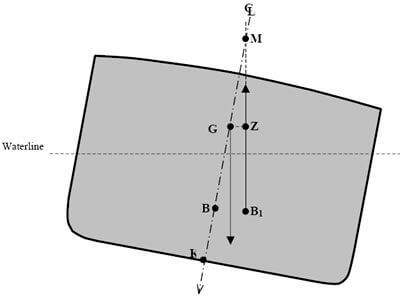Annex I- Regulations for the Prevention of Pollution by Oil
Chapter 4 – Requirements for the cargo area of oil tankers. Part A – Construction
Regulation 27 – Intact stability
1 Every oil tanker of 5,000 tonnes deadweight and above delivered on or after 1 February 2002 shall comply with the intact stability criteria specified for any operating draught under the worst possible conditions of cargo and ballast loading, consistent with good operational practice, including intermediate stages of liquid transfer operations. Under all conditions, the ballast tanks shall be assumed slack.
.1 In port, the initial metacentric height GMo, corrected for the free surface measured at 0° heel, shall be not less than 0.15 m;
.1 In port, the initial metacentric height GMo, corrected for the free surface measured at 0° heel, shall be not less than 0.15 m;
.2 At sea, the following criteria shall be applicable:
.2.1 the area under the righting lever curve (GZ curve) shall be not less than 0.055 m·rad up to θ = 30° angle of heel and not less than 0.09 m·rad up to θ = 40° or other angle of flooding θf* if this angle is less than 40°. Additionally, the area under the righting lever curve (GZ curve) between the angles of heel of 30° and 40° or between 30° and θf, if this angle is less than 40°, shall be not less than 0.03 m·rad;
.2.2 the righting lever GZ shall be at least 0.20 m at an angle of heel equal to or greater than 30°;
.2.3 the maximum righting arm shall occur at an angle of heel preferably exceeding 30° but not less than 25°; and
.2.4 the initial metacentric height GMo, corrected for free surface measured at 0° heel, shall be not less than 0.15 m.
2 The requirements shall be met through design measures. For combination carriers, simple supplementary operational procedures may be allowed.
3 Simple supplementary operational procedures for liquid transfer operations referred to in paragraph 2 (above) shall mean written procedures made available to the master which:
.1 are approved by the Administration;
.2 indicate those cargo and ballast tanks which may, under any specific condition of liquid transfer and possible range of cargo densities, be slack and still allow the stability criteria to be met. The slack tanks may vary during the liquid transfer operations and be of any combination provided they satisfy the criteria;
.3 will be readily understandable to the officer-in-charge of liquid transfer operations;
.4 provide for planned sequences of cargo/ballast transfer operations;
.5 allow comparisons of attained and required stability using stability performance criteria in graphical or tabular form;
.6 require no extensive mathematical calculations by the officer-incharge;
.7 provide for corrective actions to be taken by the officer-incharge in case of departure from recommended values and in case of emergency situations; and
.8 are prominently displayed in the approved trim and stability booklet and at the cargo/ballast transfer control station and in any computer software by which stability calculations are performed.
* θf is the angle of heel at which openings in the hull superstructures or deckhouses which cannot be closed weathertight immerse. In applying this criterion, small openings through which progressive flooding cannot take place need not be considered as open.
Help Notes:
KG – Height of the ships Center of Gravity the above Keel.
KM – Height of Metacenter above the Keel.
GM – Metacentric Height: This measurement is calculated by subtracting KG from KM (GM = KM – KG). GM is a measure of the ship’s initial stability. A larger metacentric height implies greater initial stability against overturning. Metacentric height also influences the natural period of rolling of a hull, with very large metacentric heights being associated with shorter periods of roll which are uncomfortable for passengers. Hence, a sufficiently high but not excessively high metacentric height is considered ideal for passenger ships.
GZ- Righting Arm: The distance between the forces of buoyancy and gravity is known as the ships righting arm. The righting arm is a perpendicular line drawn from the center of gravity to the point of intersection on the force of buoyancy line.
A1 Guidance to Administrations concerning draughts recommended for segregated ballast tankers below 150 m in length